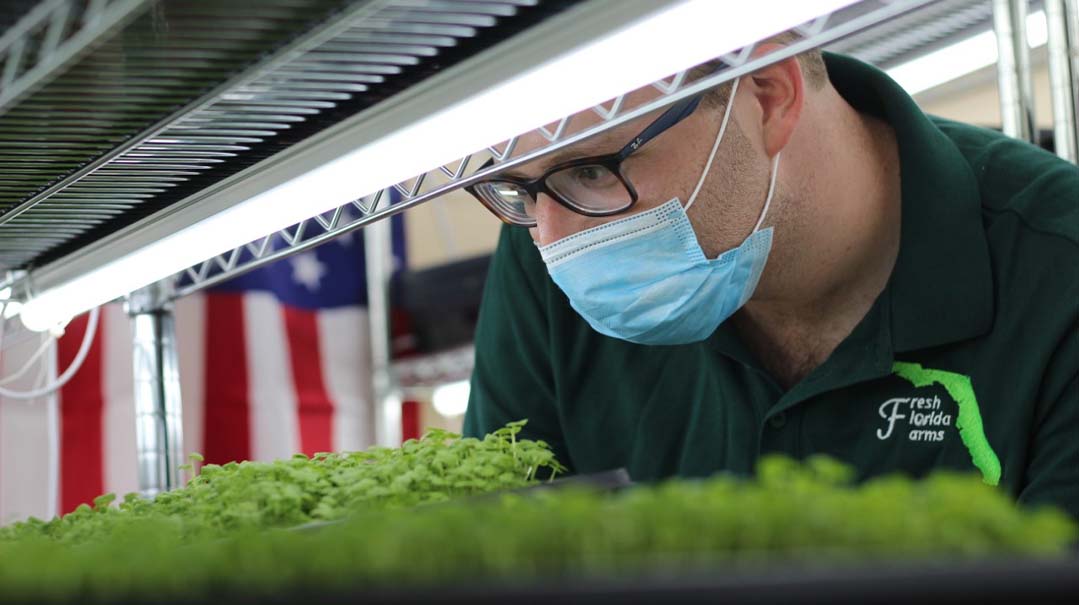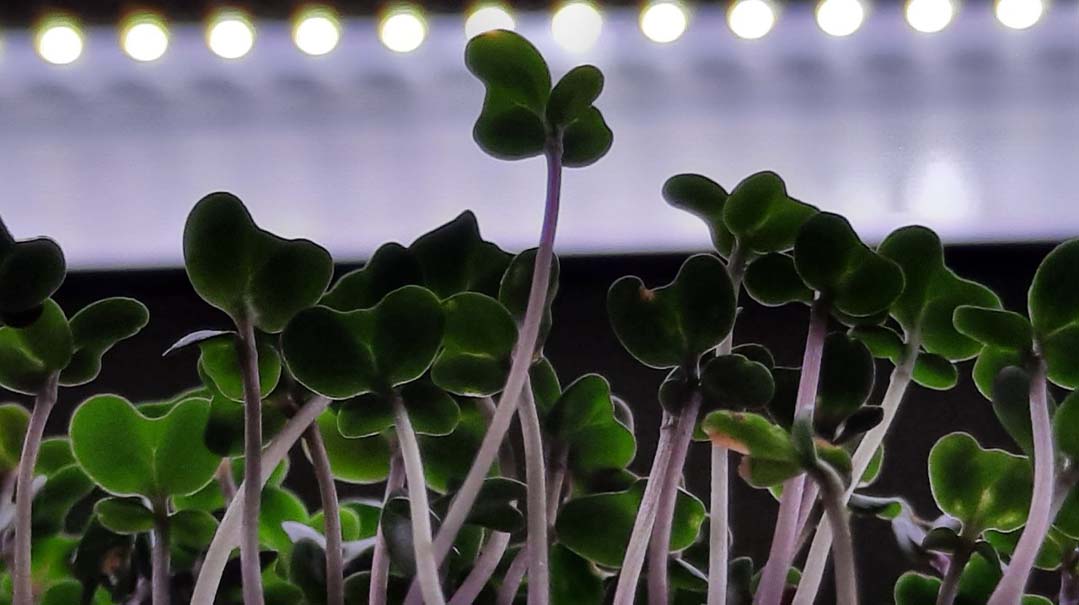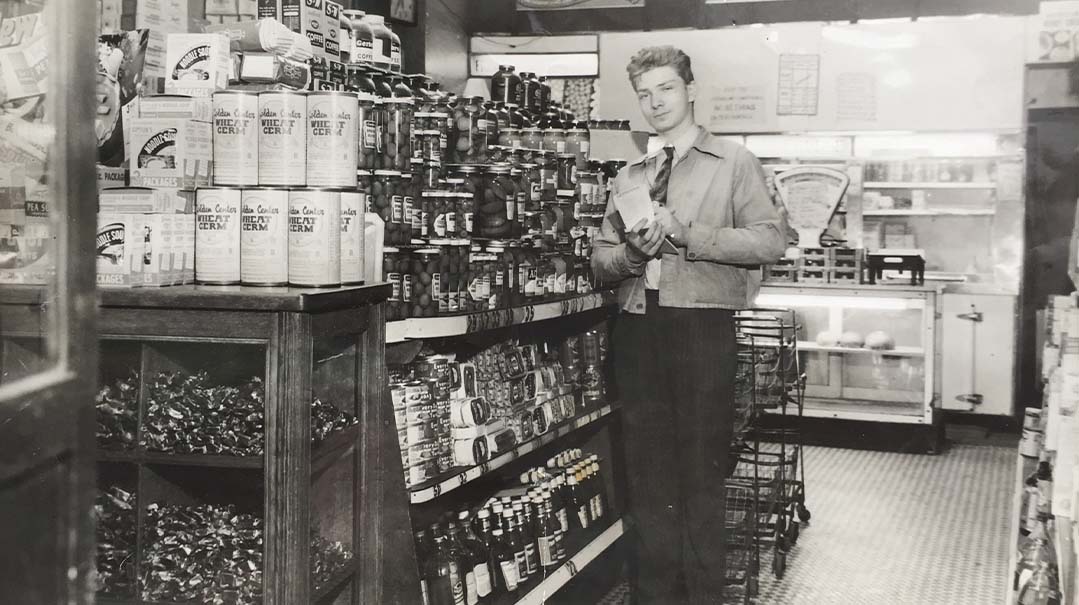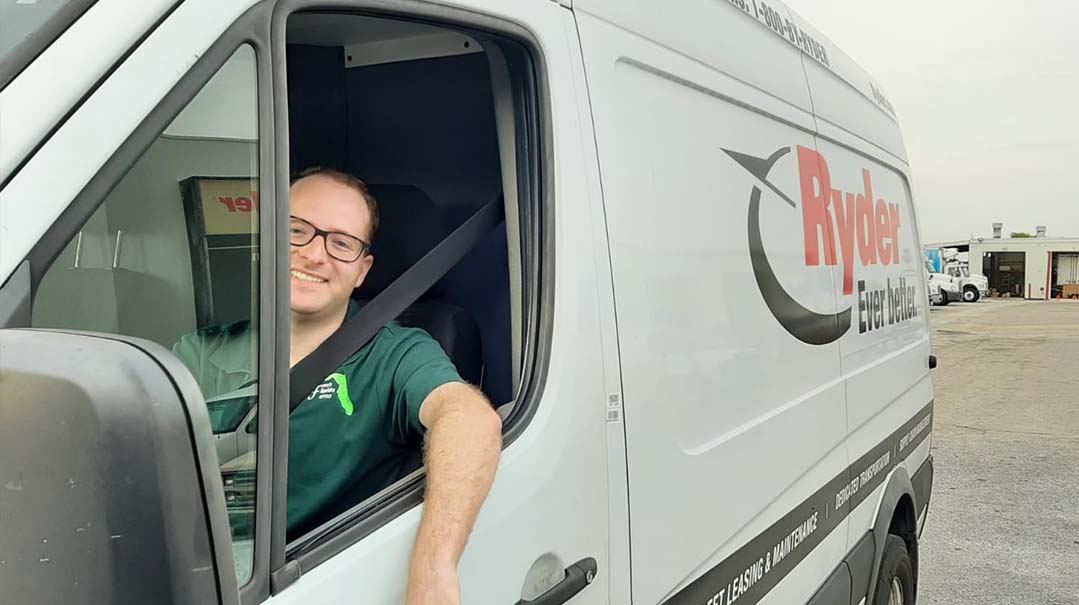A Fresh Take

"Welcome to the 21 century millennial farmer — no sunburn, straw hat, or dirt under my nails"

As fun as a visit to Florida would be, this On Site is a virtual one, for obvious reasons. Twenty-four-year-old Jonathan Rubin — farmer, scientist, environmentalist, entrepreneur — is the founder and CEO of Fresh Florida Farms, in Boca Raton. He “walks” me through his farm via phone calls and photos, and as I scroll through photos of his operation, I admire the neat shelves and rows of produce. It’s all so orderly and clean, it’s hard to believe that this is an alternative to mud-streaked farmers plowing huge fields.
“That’s because hydroponic farming doesn’t take place in the ground or in soil,” says Jonathan. “A lot of farmers are transitioning to hydroponic growing because natural resources are being used up. And if it’s done right, hydroponics can create a better quality product. And yes, the stores who sell my produce tell me I look too ‘polished’ to be a farmer. I say, ‘Welcome to the 21 century millennial farmer — no sunburn, straw hat, or dirt under my nails.’
“In general, when I meet new people and I introduce myself as a vertical farmer, they look at me as if I grew a second head. I’ve received comments like, ‘So where’s your scarecrow?’ ”
Hydroponics is the science of growing crops without soil. The produce is grown in climate-controlled environments, in tubs of water-rich nutrients, under artificial lighting. The process is cleaner, healthier, and smarter than that of soil crops because nutrients are provided directly to the plants’ roots.
Agricultural and Halachic Standards
Everything on Fresh Florida Farms is grown according to the highest agricultural standards, without genetically modified organisms (GMOs). Jonathan works closely with the USDA and FDA to ensure all standards are met or exceeded.
“It’s interesting,” he muses as I watch a clip he’s sent of a hydroponic farm, “but there’s a lot of crossover between halachah and USDA regulation.”
For example, if part of the harvest falls to the ground, the halachah says to leave it for leket. If something falls during harvesting today, USDA mandates that it can’t be sold (although for different reasons). There are also similarities when it comes to kilayim, cross-breeding two seeds.
“We don’t have to find proofs that the Torah is the end-all, but it is interesting when food policy and halachah are congruent,” says Jonathan. “Understanding and living with the complexities of food production has made me appreciate the idea of making brachos so much more.
“Because it doesn’t grow from the soil, hydroponic produce, interestingly enough, is considered bircas shehakol. (But if produce isn’t labeled hydroponic, go ahead and make ha’adamah. You can assume that it’s not hydroponic.)
“We have proven that we can grow produce, without pesticides and GMOs, and still be bug free.”

We Grow It!
We mention baby leaf lettuce because Fresh Florida Farms is currently growing a variety of leafy greens. This includes lettuce, microgreens, and sprouts. Specifically, some of the crops Jonathan is growing are arugula, broccoli, basil, radish, cilantro, and other greens. Today there are hundreds of types of microgreens used for both garnishing and their edible health benefits.
Microgreens have been proven to be 40 times more nutritious than their adult varieties. They are also rich in iron, zinc, vitamins, potassium, copper, and magnesium. They’re trending right now, and you’ll find them in the middle of every foodie discussion, but truth be told, they’ve been around since the ’80s.
“My personal favorite is basil,” says Jonathan. “It’s popular with our distributors and stores, and any extra can be turned into pesto. I’m also a big radish fan. It has a sharp flavor and can be grown in various colors like red, purple, green, and green leaf with a red or purple stem, it’s beautiful.”
He also grows something called oyster mushrooms. Although that sounds nonkosher, it’s really just a type of gilled mushrooms known for their impressive health-promoting properties. They contain a variety of powerful plant compounds and have been used in traditional medicine approaches for centuries.
You might be thinking that Jonathan has eclectic tastes in produce. Why not grow the old stand-bys, like corn or wheat or apples? Part of the reason is that hydroponic technology has not been developed yet for most fruits and vegetables. Right now the focus is on providing the best quality and freshest product to the end consumer.
Why Choose Hydroponics?
Hydroponics offers a wide array of benefits that Jonathan believes will only increase in popularity. Most obvious is the health benefit. Moreover, since the produce is not grown in soil, and is instead cultivated in climate-controlled, isolated environments, there is minimal need for hydroponic farmers to use pesticides.
“Personally,” says Jonathan, “I believe this is directly related to the overall Jewish relationship with eating healthy food. With a clear pattern in obesity uptick, ADD and ADHD, a correlation has been reported between our health and what we eat. Knowing that I am a wheel in the system feeding millions of Jews and Floridians producing healthy food is a humbling and rewarding feeling.”
There is also the sustainability benefit. Although hydroponic farming is water-intensive, it has been shown to use 95 percent less water than traditional farming methods, because its systems are designed to reuse extra water. There is no limitation of growing seasons for hydroponic farmers.
This, in turn, has an economic benefit. Currently, much of the food we consume most likely originates in another part of the world. The supply chain crisis in shipping and production caused by Covid has resulted in millions of dollars of food products being destroyed, and food shortages around the country. Hydroponics, however, can be grown locally, enabling farmers to bypass supply chain challenges and deliver their fresh farm to fork food quicker.

How It All Began
Several threads running through Jonathan Rubin’s life have intertwined to lead him on his current path.
“I was always an out-of-the-box thinker,” the Fresh Florida farmer muses. “I’m always curious about how I could make our community, our nation, and the world a better place.”
Jonathan earned his bachelor’s degree in government, diplomacy, and strategy from IDC Herzliya, Israel, and returned to America to intern in the US Congress. This was followed by a master’s in public administration at Columbia University. His studies there focused on environmental science and policy.
“Columbia University was where I first learned about futuristic growing methods,” he says.
At one point he received a university grant to design an aquaponic system — a method of simultaneously raising fish and growing produce in a shared ecosystem. The fish fertilized the plants and in turn the plants cleaned the water. This later morphed into his present hydroponic system.
Nothing about that sounds simple, but hey, I’m not a farmer.
We Are Family
As far as Jonathan knows, he’s the first in his family to engage in agriculture — although he can point to many ancestors in the food business.
“My entire immediate family is in medicine,” he says. “But if you look back to when we first came to America in the early 1900s, you’d see that both sides of my family were in the wholesale and retail food business in New York.
His siblings and relatives are out of the farming loop, but he counts about a dozen friends focusing on other aspects of the food industry. “We compare notes. A few are food engineers for major companies and some have farms too.”
He’s certainly off to a good start: his produce is found in stores across Florida, and is actively expanding.
Work in Progress
Jonathan’s road to success has not been free of potholes. Although in the long term hydroponics can potentially solve local food shortages, in the short term Jonathan finds that kinks in the supply chain are affecting him.
“For example, I needed some specific wheels and pumps, and they were not available,” he recounts. “Equipment suppliers are suggesting purchasing more supplies upfront due to shipping challenges throughout North America. Once the items make it to the US, there are trucking challenges. Acquiring seeds has also become a major challenge. Seed costs have increased — assuming there is even supply — which will cause major problems in the supply chain a few months from now.”
Yikes, sounds even worse than missing a writing deadline.
“It’s pretty hard,” he agrees. “There are challenges in making a budget also, since the cost of items — from seeds to trays to containers, and everything in between — has gone up in price. What I budget for today needs to account for a price that doesn’t yet exist.”

Morning on the Farm
In the meantime, Jonathan’s home base seems to be providing the optimal growth environment for his business, in more ways than one. He has to maintain a challenging pace to keep up with it all.
“In Florida,” Jonathan explains, “the vacation population can triple in the winter and the holidays. So while the crop can be grown year-round in a climate-controlled setting, there are definitely different seasonal demands.”
As far as his daily work schedule goes, there’s plenty to keep him busy, even if there are no roosters crowing or cows to milk.
“On the farming side, I perform daily inspections on my crop,” he explains. “This can include checking the water and air temperatures. I then inspect the plants to ensure they are up to par with USDA, FDA, and kashrus standards. If there’s an issue, such as a mold or algae bloom, I remedy it as needed.
“My plants ‘wake up’ at 6 a.m. and go to sleep at 8 p.m., giving them 14 hours of ‘sunlight.’ Most of my time is spent working with NGOs, researchers, county, state, and federal government agencies, and distributors.”
Well, I’m converted. Show me a bug-free, clean, crisp, and delicious salad, and I’m there for it. Throw in some plans for the young Jews’ future, and it’s easy to see why Jonathan Rubin and Fresh Florida Farm has been blessed with such growth (pun intended).
(Originally featured in Mishpacha, Issue 898)
Oops! We could not locate your form.






